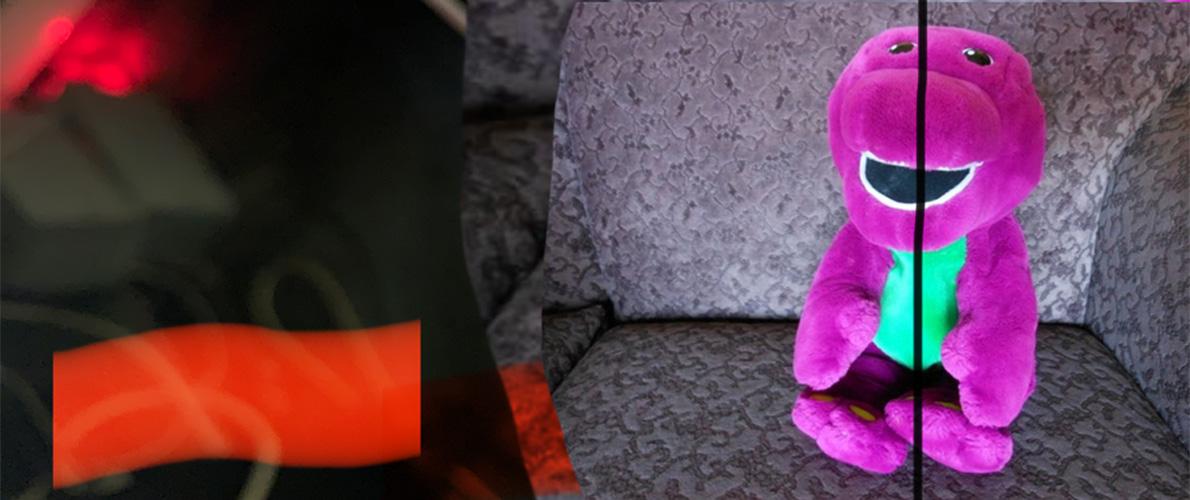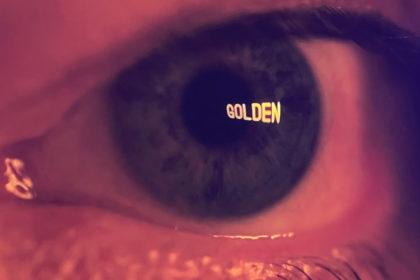Authour: Katya Babikova
Nata Yanchur works with digital and analogue painting, creating abstract images. She manipulates photographs of material object; converting them into digital formats, cropping, expanding, and making them completely unrecognizable. The artist uses the resulting textures as a canvas to create a digital painting by layering abstract lines and patterns. Nata reinvents painterliness in the digital environment, emphasizing the virtualization of artistic production She pushes her imagery to its limit, insisting on no narrative meaning and non-recognition. The result is abstraction, both in the artistic sense, and the loss of connection with the real signified by the images, empty sign simulation.

Nata Yanchur. Lollipop, from “Speculation on hot topics” series, digital painting, 2022
Such work with images, as Nata says, is designed to “determine the degradation boundaries” of the familiar visuality in which we are immersed, bringing it to the point of absurdity and unrecognizability, or the other way around; to the emergence of new metaphors and memories. Looking at Nata’s works, you involuntarily catch yourself trying to find familiar outlines, anthropomorphic characteristics on the surface of a digital canvas created exclusively with textures, lines, and dots. In text Sea of Data. Apophenia and patterns of (non-)recognition Hito Steyerl argues that the new normality of overproduction of visual content and information noise implies the inability of our sense organs to identify and catch its total presence [1]. Even Walter Benjamin in his A Brief History of Photography says that the nature facing the eye is not equal to the nature facing the camera [2]. The photographed image allows us to open the unconscious. Nata Yanchur does not always use photographs as the initial stage of her work. Most of the time she works with the “frame” randomness, adds lines on the canvas, intuitively completing images, making visible automatic patterns that already live in our unconscious.

Nata Yanchur. Tongue and dog, from “Funny pictures” series, digital painting, 2020
According to Steyerl, one of the “secret ninja techniques” in the midst of a sea of unrecognizable data could be apophenia[3]. “Apophenia” means recognizing patterns, regularities in seemingly random information [4]. The most obvious example of apophenia is the recognition of faces in clouds or on the lunar surface. Apophenia is “the establishment of correlations between sources that have no other connection than their simultaneous presence in perception,” as Benjamin Bretton has recently said [5]. Yanchur’s works allow us to reflect on the automation of visual perception and artistic production in current conditions.

Nata Yanchur. Cloud, from “Endless Exhibition” series, digital painting, 2021
Nata started creating digital art at the age of 12 using free apps. Yanchur compares the availability of drawing apps to the production of cave painting. Modern artists, like our predecessors of the Paleolithic, seem to be scratching out lines and images, however, this time on a tablet, in an attempt to reflect the reality available to them. In her series of animalistic images the artist reflects on their omnipresence. Can they be a reminder of the material organic world torn from the subconscious, in which the digital content we have created circulates? The artist does not try to run away from the production of such mechanical images, allowing the audience to catch the familiar animalistic outlines and, for a moment, experience the pleasure of being able to recognize abstraction. This pleasure fuels the modern circulation of memes and pictures in social networks. Nata refuses direct criticism and dismissal of what Adorno and Horkheimer called “the cultural industry.” On the contrary, her work easily fits into the culture industry, bringing its entertaining and lively images to a picturesque absurdity.

Nata Yanchur. Cookie, from “Endless Exhibition” series, digital painting, 2021
Hito Steyerl reflects on how the perception of abundant content effects the creation of new technologies that allow us to classify and rank all the data that comes to us about the world around us: “But what are we going to make of automated apophenia? Are we to assume that machinic perception has entered its own phase of magical thinking? Is this what commodity enchantment means nowadays: hallucinating products? It might be more accurate to assume that humanity has entered yet another new phase of magical thinking” [6]. Nata captures the presence of magical thinking and focuses the viewer’s attention on their own perception. At the same time, there is no classification or applied function in her works. Yanchur’s painting refuses to fall into the classical hierarchies of art history, but naturally merges with modern visuality.

Nata Yanchur. Wolves wolves! from “Speculation on hot topics” series, digital painting, 2022
Steyerl nevertheless divides the original and modern type of “Neolithic” thinking. In ancient astronomy the constellations were understood as a projection of animal forms onto the sky. With the development of progress, the belief that animals and gods live in space has disappeared, but the understanding of space through our physical logic has not gone anywhere. All of our data and measurements of the world are projections; not reality. “While today statisticians and other experts routinely acknowledge that their findings are mostly probabilistic projections, policymakers of all sorts conveniently ignore this message. In practice you become coextensive with the data-constellation you project. Social scores of all different kinds—credit scores, academic scores, threat scores—as well as commercial and military pattern-of-life observations impact the real lives of real people, both reformatting and radicalizing social hierarchies by ranking, filtering, and classifying” [7].





Thus, a comparison with cave art can be the key to understanding Yanchur’s gestures. Her practice combines primitive forms, accessible production tools and methods of communication and distribution through social networks. She points us to a special kind of technological shamanism where technologies can be used to create the simplest forms, or return us to the origins of painting. The artist’s actions reveal a form of art production – the most accessible and attractive to an eye oversaturated with images. Bright colors and unexpected abstract shapes have the potential to push us out of our unconscious content consumption and draw attention to ourselves. Having received an invitation to pause and stick to picturesque objects the audience gets a moment to reflect. The artist forces a pause in the endless consumption of entertainment content. Abstract images, playing according to the rules of the attention economy and the entertainment industry, occupy the space within these logics and free it for the possible birth of new ideas and meanings. It is necessary to claim this space for ourselves by any means.

Nata Yanchur. “Illumination”, from “Endless Exhibition” series, digital painting, 2021-2022
NOTES:
[1] Hito Steyerl. Sea of Data: Apophenia and Patterns of (Non-)Recognition// https://www.e-flux.com/journal/72/60480/a-sea-of-data-apophenia-and-pattern-mis-recognition/
[2] Walter Benjamin. A Brief History of Photography// Ad Marginem Press 2013
[3] Hito Steyerl. Sea of Data: Apophenia and Patterns of (Non-)Recognition// https://www.e-flux.com/journal/72/60480/a-sea-of-data-apophenia-and-pattern-mis-recognition/
[4] Link: https://en.wikipedia.org/wiki/Apothenia
[5] Benjamin H. Bratton, “Some Trace Effects of the Post-Anthropocene: On Accelerationist Geopolitical Aesthetics,” e-flux journal 46 (June 2013)
[6] Hito Steyerl. Sea of Data: Apophenia and Patterns of (Non-)Recognition// https://www.e-flux.com/journal/72/60480/a-sea-of-data-apophenia-and-pattern-mis-recognition/
[7] Ibid.
Katya Babikova (born 1988, Russia) – curator and translator. Studied Directing at the School of Visual Arts in NY. Worked in contemporary art galleries in NY since 2012: Resobox Gallery (Japanese Cultural Center) and Soho20 Gallery. Currently lives in Barcelona, Spain.
Nata Yanchur (female), born in 1990 in Minsk, Belarus, based in London, UK. She has degree in Art from the Faculty of Contemporary Art, High School “Sreda Obuchenia”, has Bachelor degree of history and social sciences, Belarusian State University. She participated in the numerous international projects and exhibitions in the field of contemporary art. The sphere of her professional interests is visual arts: painting, drawing, digital art.
Instagram: https://www.instagram.com/nata00yanch/
Website: https://natayanchur.com/





